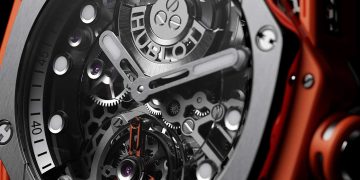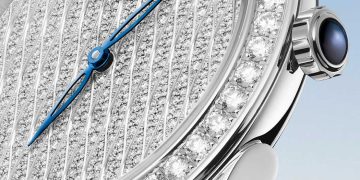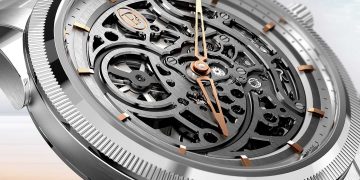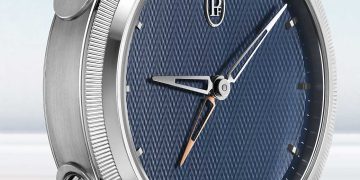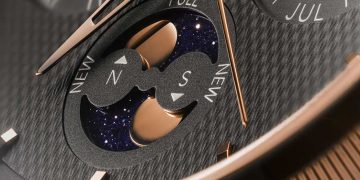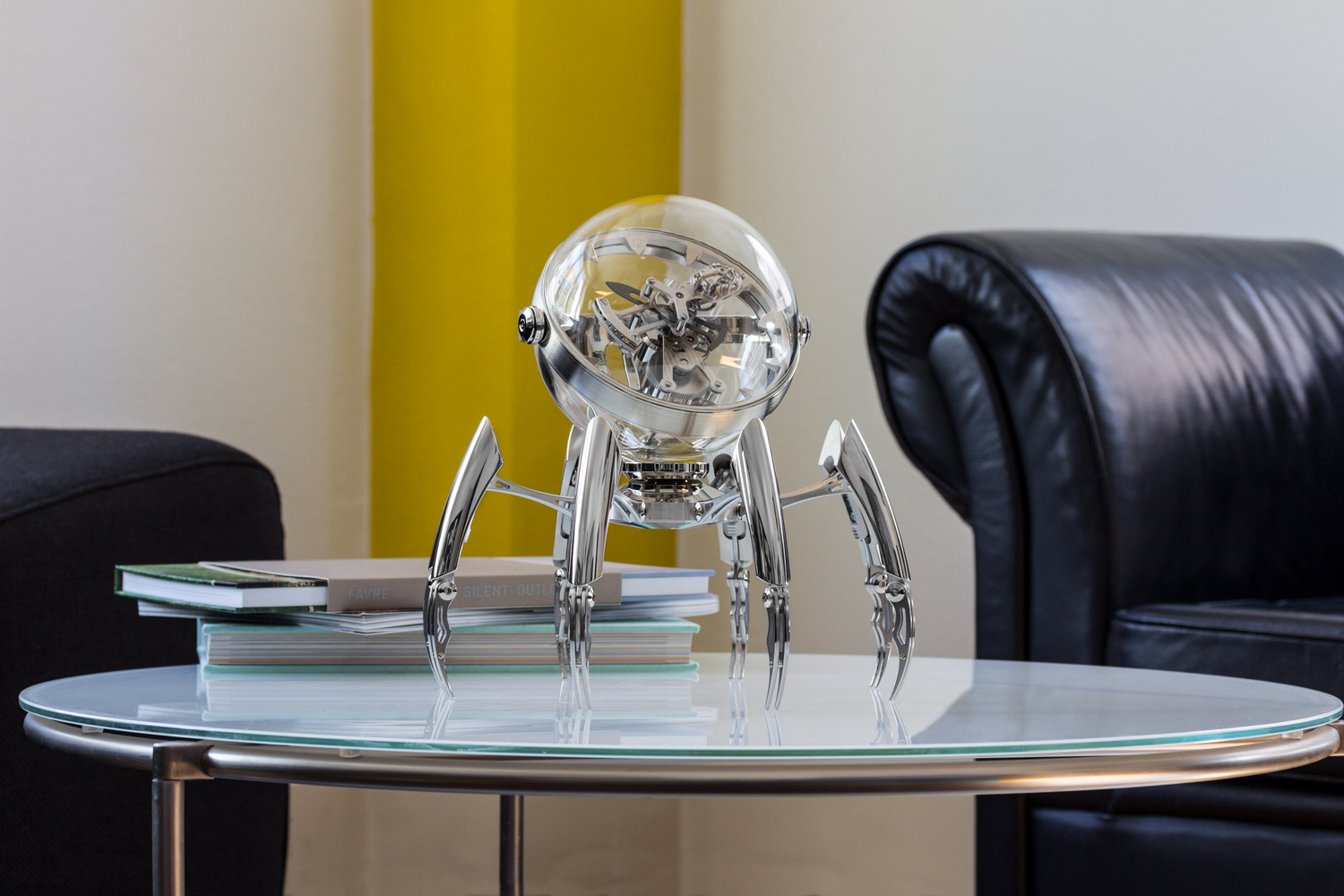
Octopod continues MB&F’s exploration of aquatic themes with an eight-leg, eight-day clock inspired by cephalopods, marine chronometers and The Abyss – blending contemporary design with kinetic sculpture and a transparent bubble filled with precision horology.
Conceived by MB&F and built by Switzerland’s premier clock maker, L’Epée 1839, Octopod stands or crouches thanks to its eight articulated legs. Each leg can be individually adjusted to varying heights, enabling Octopod to rest securely on the most uneven of surfaces, just like a real octopus.
However, the real horological magic and mystery take place in Octopod’s completely transparent spherical ‘head’.
The first thing to notice is that Octopod’s transparent sphere is gimballed in a similar way to how traditional ship chronometers were gimballed – although on one axis rather than two – so that they remained flat despite the pitching and rolling of the ship. In Octopod’s case, the gimbal ensures that no matter what angle or height it sits, it is easy to rotate the bubble so that the time display inside is at the ideal plane for maximum legibility.
The second thing the attentive eye will notice is that Octopod’s pulsating escapement, which regulates the clock’s precision, is located on its minute hand rather than the more usual (and mechanically simpler) position attached to stationary movement plates. While not technically a tourbillon according to Abraham-Louis Breguet’s original patent, with its movement vertical, the 60-minute rotation of Octopod’s regulator on the minute hand is closer to the primary aim of Breguet’s invention. His intention was to rotate the escapement of a pocket watch sitting vertically in a fob pocket to average out positional errors, while wristwatch tourbillons are continually moving through all positions without requiring 360° rotations.
And thirdly there’s the mystery of how Octopod’s clockwork is suspended inside its crystalline sphere, so that it appears to be floating in space (or water). The baseplate of the movement is a transparent glass plate that has been treated with a film of anti-reflective coating on both sides so that it is virtually invisible. Like an octopus concealing parts of itself with camouflage, Octopod conceals parts of itself with visual tricks of its own.
Octopod’s eight-day movement is an entirely new development by L’Epée 1839, with both the glass baseplate and counterbalanced regulator posing particular challenges.
Along with its octopus and marine chronometer connections to the sea, Octopod also brings to mind the then futuristic glass bathysphere of James Cameron’s 1989 film, The Abyss. While the viewer may be outside looking in at the transparent bubble, it’s easy to imagine sinking below the waves and looking out at the astonishing iridescent creatures of the deep oceans. However, you may well rest assured that despite its aquatic inspirations, Octopod is perfectly at home on dry land.
Octopod is available in 3 limited editions of 50 pieces each in black PVD, blue PVD, and palladium (silver).
Octopod in detail
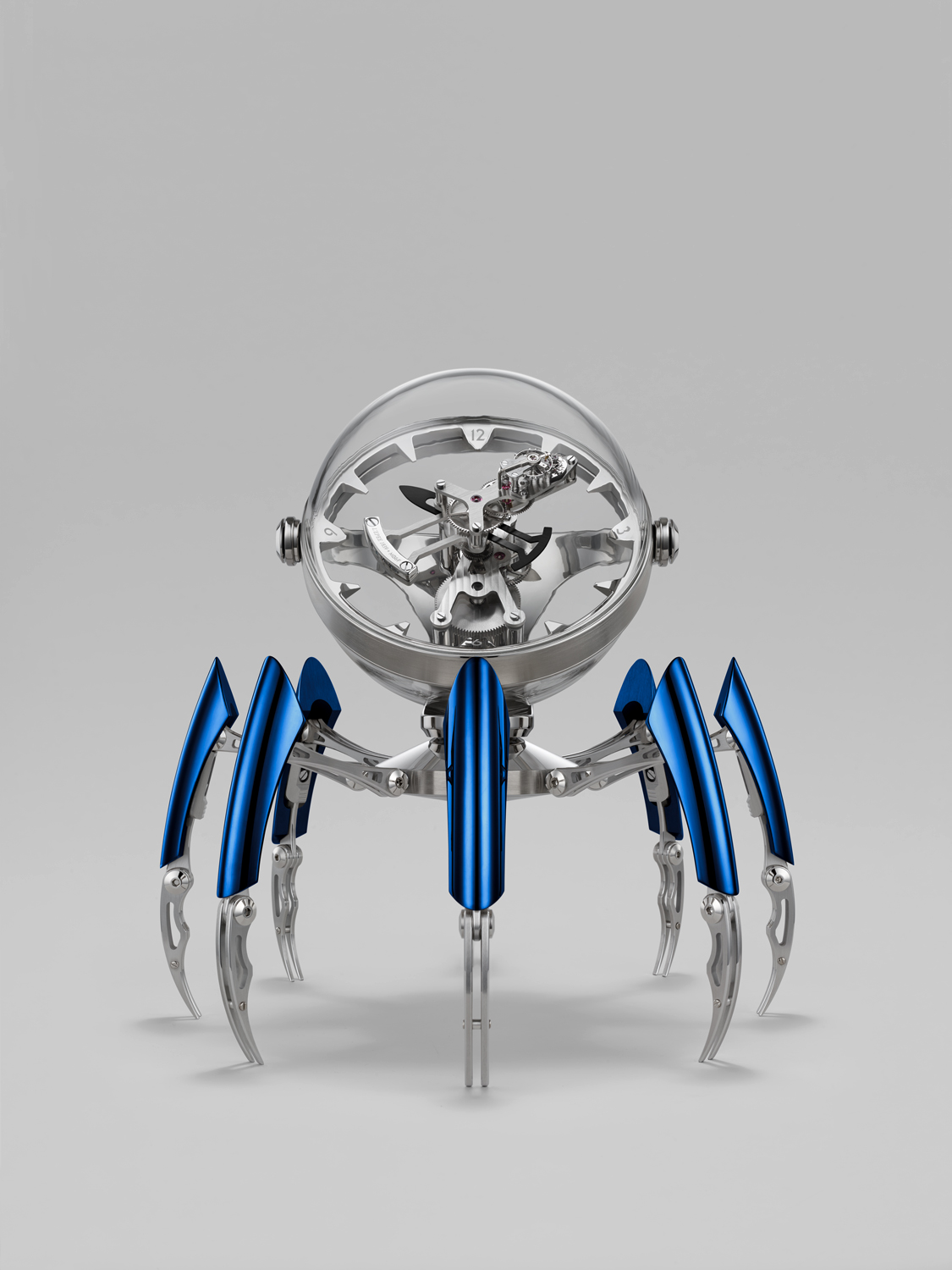
Inspiration
Octopod’s idiosyncratic design derives from three aquatic sources: the highly intelligent octopus with its ‘eight legs’ (more on that below) provided the inspiration for the eight articulated legs, while the gimballed traditional marine chronometer inspired the partially gimballed sphere housing the clockwork and time display. And then there is the transparent bubble evoking memories of the bathysphere in James Cameron’s 1989 sci-fi classic The Abyss.
The original sketch MB&F gave to L’Epée 1839 showed the movement ‘floating’ inside the transparent bubble, but this was more to allow the manufacture more latitude in developing the support structure for the clockwork, than an expectation that a ‘floating’ movement was actually possible. Not for the first time (nor hopefully the last), L’Epée 1839 went far and beyond the brief to create something even more exceptional than planned.
Realisation
While MB&F came up with the concept and design of the Octopod, it was L’Epée 1839, Switzerland’s premier clock maker, that developed the movement as well as the unusual transparent spherical case and articulated legs. L’Epée produces most of the components, puts them all together and regulates the high precision, eight-day clockwork.
While nothing about this atypical project was easy, L’Epée faced two major challenges. The first was in finding a supplier for the glass baseplate able to work to the tight tolerances required, as companies cutting and drilling glass were not used to working to the extreme precision demanded by horology. The complete movement is mounted on the glass baseplate, so the position of the diamond-drilled holes was of critical importance.
The second significant challenge was in having to adjust the counterweight for the regulator-bearing minute hand in three dimensions. Originally two counterweight screws were thought to suffice, but it was quickly discovered that five minuscule adjusters were necessary to ensure that the minute hand was perfectly balanced for optimal timekeeping precision.
Octopuses
Let’s get one thing out of the way first: it is ‘octopuses’ not ‘octopi’ as the root of the word comes from Greek, not Latin. And secondly, despite what is commonly thought, octopuses do not have eight legs (or even eight arms), but two legs and six arms. The cephalopods use their two rear appendages (legs) for locomotion or propulsion when moving along the sea bed and their six arms for manipulating food and objects. While all of their limbs look similar, they are anatomically three pairs of arms and a pair of legs.
Octopuses are very intelligent creatures and are the most intelligent of invertebrates. Maze and problem-solving experiments have indicated sophisticated memory systems and some species have been observed using tools. When threatened, octopuses have a number of defences including very effective camouflage (their skin can change colour like a chameleon), water with jet propulsion, and releasing a cloud of ink to obscure and confuse.
Octopod: Technical Specifications
Octopod is available in 3 limited editions of 50 pieces each in black PVD, blue PVD, and palladium (silver).
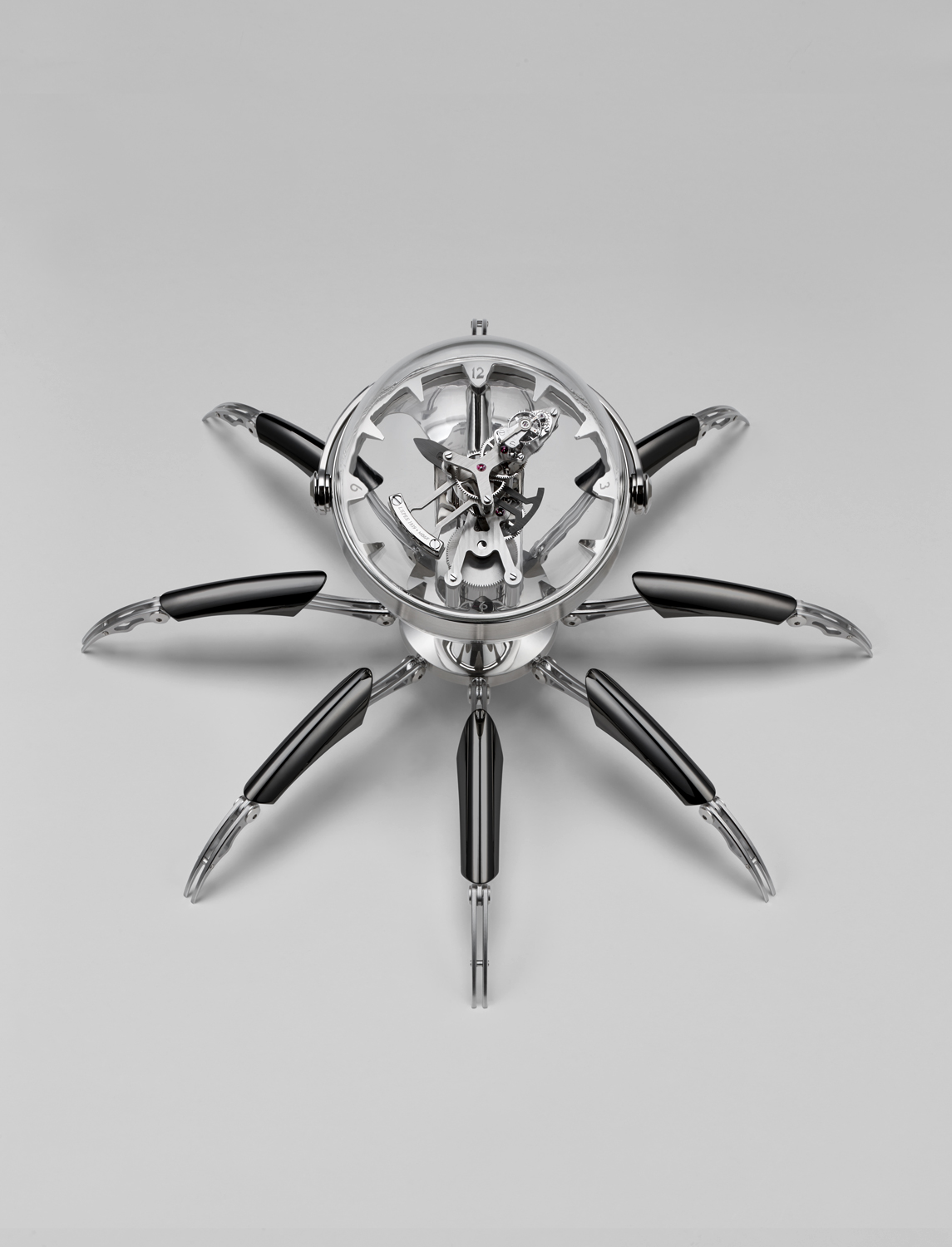
Indications and complications
Hours, minutes and finely counter-balanced regulator mounted on minute hand
Body
Dimensions: 28 cm long x 28 cm high (standing), 45 cm long x 22 cm high (crouching)
Weight: 4.2 kg
Frame: Stainless steel, nickel and palladium plated brass
Components (body, legs and sphere): 309
Legs
8 legs each composed of 31 pieces
Articulation released by a button in each leg, can be locked in two positions (standing or extended)
Sphere
360° rotation in both vertical and horizontal planes with 3 sand-blasted and satin-finished brass rings.
Two Polycarbonate hemispheres joined by a satin-finished three-piece band
Movement
L’Epée in-house designed and manufactured
Baseplate in transparent mineral glass, anti-reflective coating both sides
Balance frequency: 2.5 Hz / 18,000 bph
Power reserve: 8 days from single barrel
Components movement: 159
Jewels: 19
Incabloc shock protection system protected by mineral glass
Materials: palladium-plated brass, stainless steel and nickel-plated brass
Manual-winding: the double-depth square socket key sets time and winds movement
MB&F – Genesis of a Concept Laboratory
In 2015, MB&F celebrated its 10th anniversary – and what a decade it was for the world’s first ever horological concept laboratory: 10 years of hyper-creativity; 11 remarkable calibres forming the base of the critically acclaimed Horological Machines and Legacy Machines for which MB&F has become renowned.
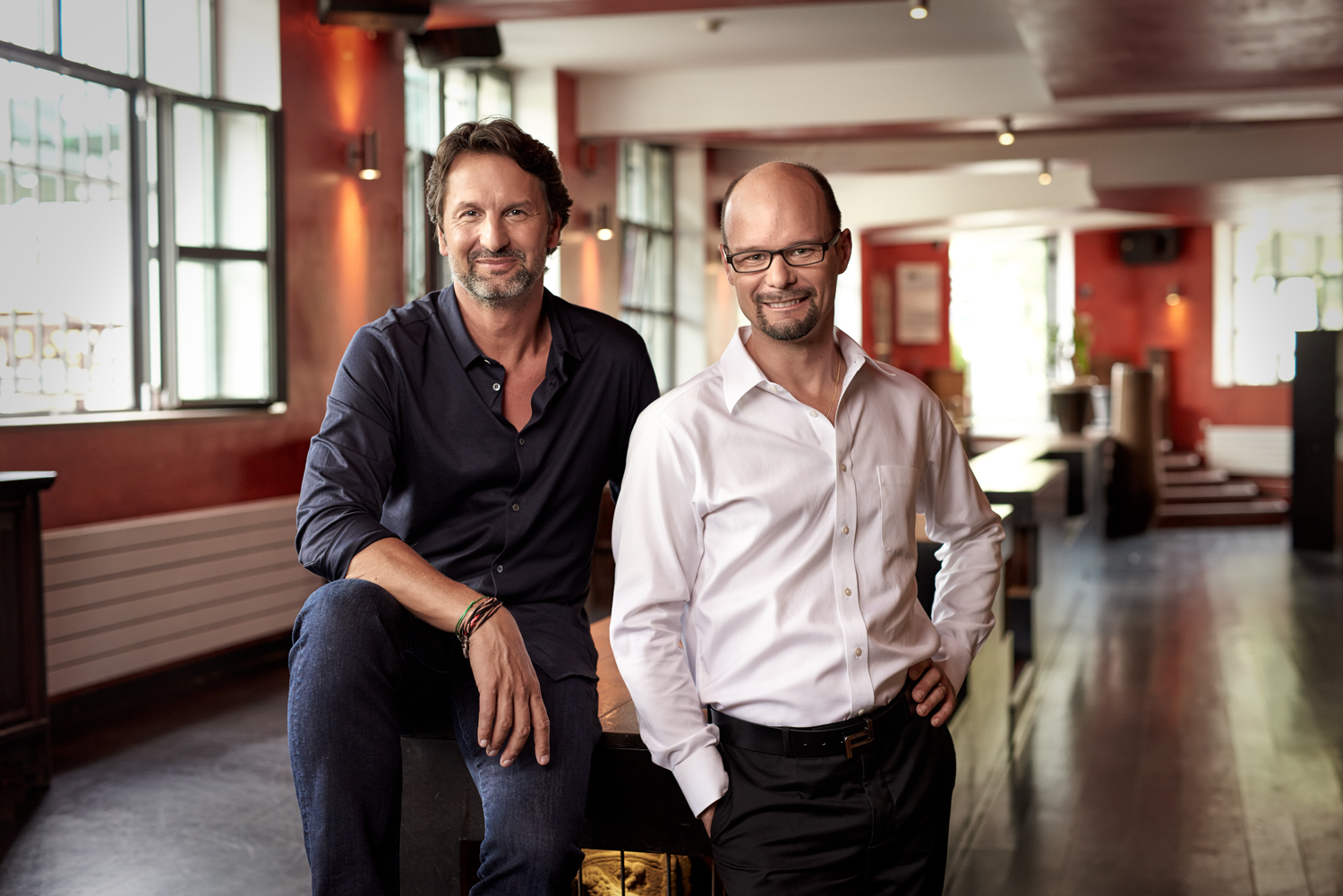
After 15 years managing prestigious watch brands, Maximilian Büsser resigned from his Managing Director position at Harry Winston in 2005 to create MB&F – Maximilian Büsser & Friends. MB&F is an artistic and micro-engineering laboratory dedicated to designing and crafting small series of radical concept watches by bringing together talented horological professionals that Büsser both respects and enjoys working with.
In 2007, MB&F unveiled its first Horological Machine, HM1. HM1’s sculptured, three-dimensional case and beautifully finished engine (movement) set the standard for the idiosyncratic Horological Machines that have followed: HM2, HM3, HM4, HM5, HM6, HM7, HM8 and HMX – all Machines that tell the time, rather than Machines to tell the time.
In 2011, MB&F launched its round-cased Legacy Machine collection. These more classical pieces – classical for MB&F, that is – pay tribute to nineteenth-century watchmaking excellence by reinterpreting complications from the great horological innovators of yesteryear to create contemporary objets d’art. LM1 and LM2 were followed by LM101, the first MB&F Machine to feature a movement developed entirely in-house. The year 2015 saw the launch of Legacy Machine Perpetual featuring a fully integrated perpetual calendar. MB&F generally alternates between launching contemporary, resolutely unconventional Horological Machines and historically inspired Legacy Machines.
As well as Horological and Legacy Machines, MB&F has created space-age MusicMachines (1, 2 and 3) in collaboration with music box specialist Reuge; and with L’Epée 1839, unusual clocks in the form of a space station (Starfleet Machine), a spider (Arachnophobia) and three robot clocks (Melchior, Sherman, and Balthazar). In 2016, MB&F and Caran d’Ache created a mechanical rocket-pen called Astrograph and in 2017 Destination Moon in collaboration with L’Epée 1839.
And there have been distinguished accolades reminding us of the innovative nature of MB&F’s journey so far. To name a few, there have been no less than 4 Grand Prix awards from the famous Grand Prix d’Horlogerie de Genève: in 2016, LM Perpetual won the Grand Prix for Best Calendar Watch; in 2012, Legacy Machine No.1 was awarded the Public Prize (voted for by horology fans) and the Best Men’s Watch Prize (voted for by the professional jury); and in 2010, MB&F won Best Concept and Design Watch for the HM4 Thunderbolt. In 2015 MB&F received a Red Dot: Best of the Best award – the top prize at the international Red Dot Awards – for the HM6 Space Pirate.
L’EPEE 1839 – the premier clock manufacture in Switzerland
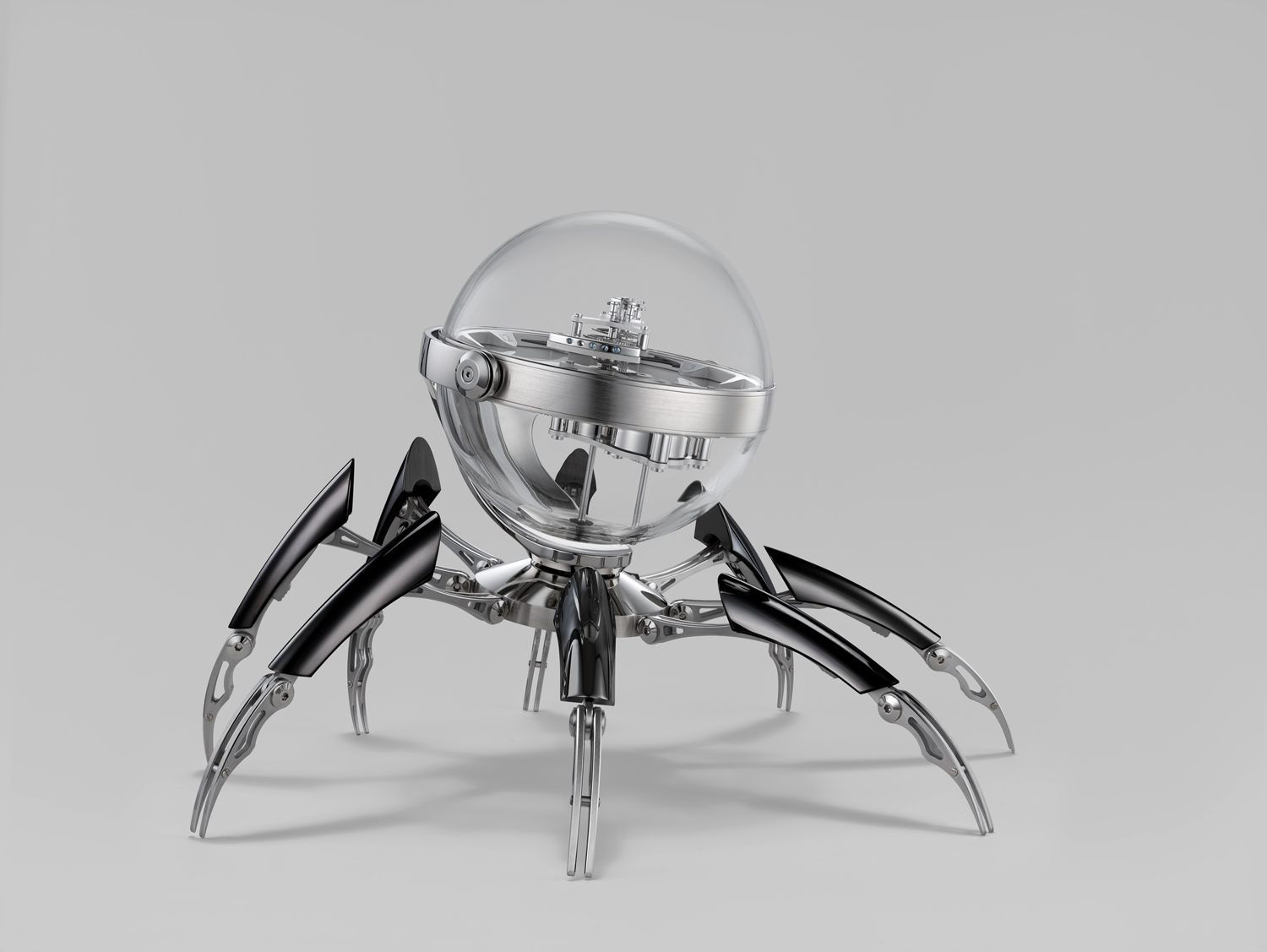
For more than 175 years, L’Epée has been at the forefront of clock making. Today, it is the unique specialised manufacture in Switzerland dedicated to making high-end clocks. L’Epée was founded in 1839, by Auguste L’Epée, who set up the business near Besançon, France to make music box and watch components.
From 1850 onward, the manufacture became a leading light in the production of ‘platform’ escapements, creating regulators especially for alarm clocks, table clocks and musical watches. By 1877, it was making 24,000 platform escapements annually. The manufacture became a well-known specialist owning a large number of patents on special escapements such as anti-knocking, auto-starting and constant-force escapements and the chief supplier of escapements to several celebrated watchmakers of the day. L’Epée has won a number of gold awards at international exhibitions.
During the twentieth century, L’Epée owed much of its reputation to its superlative carriage clocks and, for many, L’Epée was the clock of the influential and powerful; it was also the gift of choice by French government officials to elite guests. In 1976 when the Concorde supersonic aircraft entered commercial service, L’Epée wall clocks were chosen to furnish the cabins, providing passengers with visual feedback of the time. In 1994, L’Epée showed its thirst for a challenge when it built the world’s biggest clock with compensated pendulum, the Giant Regulator. At 2.2 m high, it weighs 1.2 tons – the mechanical movement alone weighs 120 kg – and required 2,800 man-hours of work.
L’Epée is now based in Delémont in the Swiss Jura Mountains. Under the guidance of CEO Arnaud Nicolas, L’Epée 1839 has developed an exceptional table clock collection, encompassing a range of sophisticated classic carriage clocks, contemporary design clocks and avant-garde horological sculptures. L’Epée clocks feature complications including retrograde seconds, power reserve indicators, perpetual calendars, tourbillons and striking mechanisms – all designed and manufactured in-house. Ultra-long power reserves have become a signature of the brand as well as superlative fine finishing.

